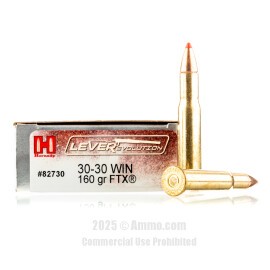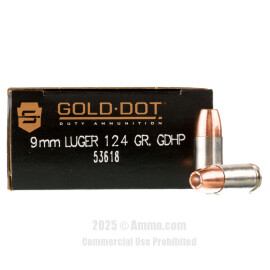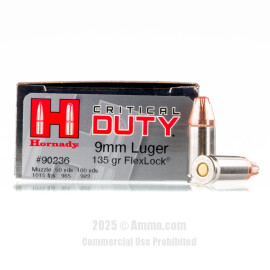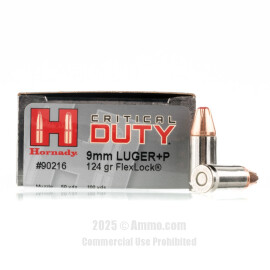Hornady Critical Duty 9mm Ammo Review: Stop the Threat
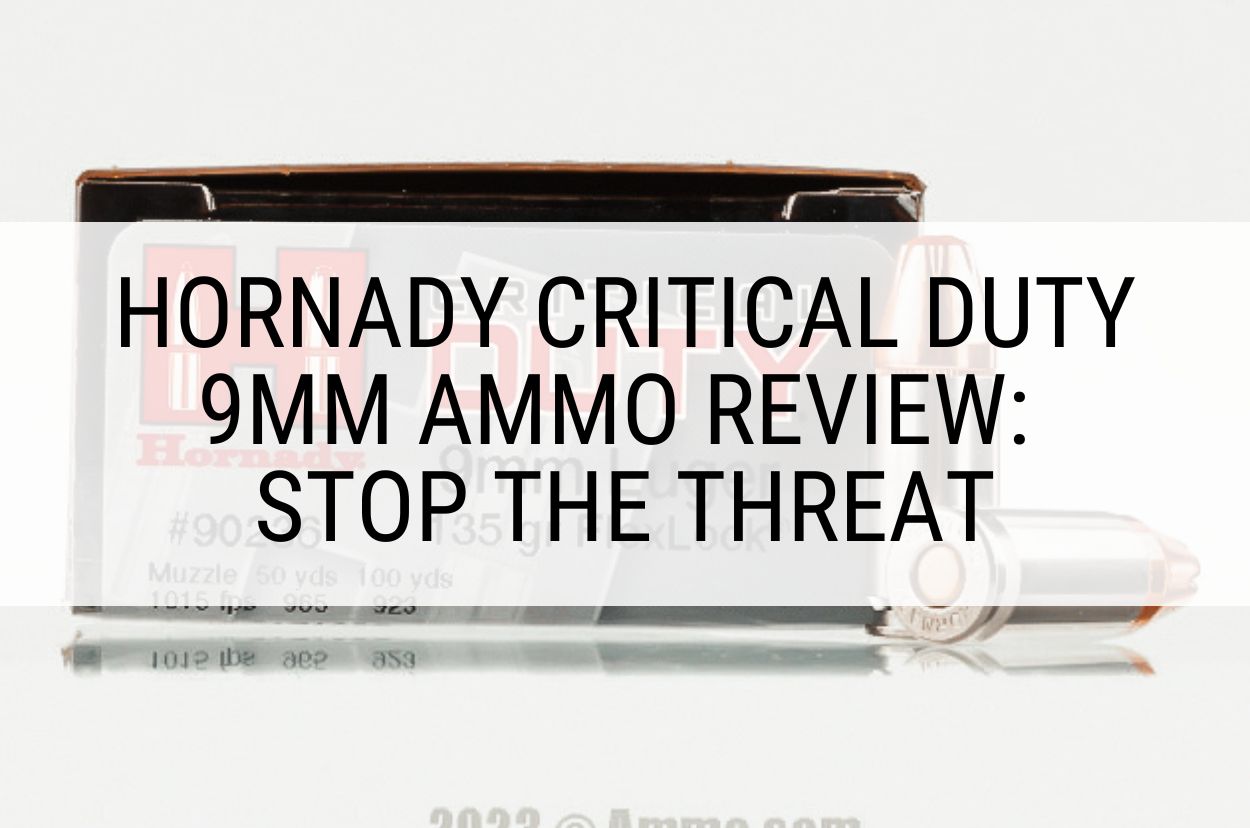
If you’re looking for one of the best personal defense 9mm loads available on the market today, then look no further than Hornady Critical Duty JHP ammo. Loaded with the revolutionary FlexLock bullet, Critical Duty ammo destroys all the FBI gel tests and is approved for use by law enforcement officers.
However, some shooters wonder if the 9mm Critical Duty load is right for their EDC. Thankfully you found this article, and I’ll be happy to sort that out for you.
In this Hornady Critical Duty 9mm ammo review, we will cover the research and development that went into this defense round and what it’s capable of. Furthermore, I’ll share with you my review of Critical Duty ammo and help you decide if this is the defense round you should be loading in your CCW mags.
However, if you’re ready to pull the trigger on some Critical Duty ammo, make sure you check out everything we have in stock on our Hornady ammo page. And if you're considering buying in larger quantities, don't forget to visit our bulk 9mm ammo page for great deals on extensive stock options.
Now, let’s get to the review!
Hornady Critical Duty 9mm Ammo Overview
Released in 2011, the Hornady Critical Duty line of ammunition is designed to meet the needs of law enforcement and pass the criteria of the FBI Protocol. The FBI Protocol is a test that utilizes ballistic gelatin and multiple barriers to test the effectiveness of handgun defense rounds.
Per FBI testing requirements, a hollow point should penetrate between 12-18 inches (ideally 15 inches) into ballistic gelatin while being shot through heavy clothing, drywall, sheet metal, plywood, and auto glass.
Development of the Critical Duty bullet began in 1996 when Dave Emary, father of the 6.5 Creedmoor, began experimenting with polymer-tipped handgun bullets. At the time, Emary tried drilling out a 45 ACP XTP hollow point and filled the cavity with bathtub caulk.
Expansion and penetration results were positive, but the technology to mass produce this type of round did not exist at the time. However, not dismayed, Emary continued to work on polymer-tipped bullets in rifle rounds which eventually led him to the development of the LeveRevolution in 2005.
The LeveRevolution line of ammunition featured Emary’s groundbreaking Flex-Tip (FTX) bullet. The FTX (and MonoFlex) bullets use an elastomer tip that allows Spitzer bullets to be safely loaded into tubular magazines.
Traditionally, lever-action rifles had to be loaded with flat-point bullets to prevent the nose of a bullet loaded into the magazine from igniting the primer in the round ahead of it. However, Emary’s FTX bullets used a rubber tip to prevent this whilst increasing the ballistic coefficient and muzzle velocity of the round in general.
Then in 2006, the grandson of founder Joyce Hornady, Jason, was tasked by his father to win an FBI contract for handgun ammunition. At this point, Hornady had been unsuccessful at landing any law enforcement contracts for handgun duty ammo.
To that point, Hornady Ballisticians had only been successful at integrating the FTX bullet design into 380 ACP bullets. Furthermore, Hornady decided to put their efforts towards producing a new bullet for the civilian concealed carry market, so the development of the Critical Duty was shelved for two more years.
The use of the flexible FTX polymer tip that prevented clogging of the hollow point and aided in expansion was very successful, and Critical Defense ammo was born. Although Critical Defense was very popular with civilian EDC shooters, one major failing was that did not pass FBI tests for penetration through auto glass.
So, in 2008, Jason Hornady and his team got back to work on creating a purpose-built law enforcement round that met all the FBI’s requirements.
Although the FTX polymer tip was nearly successful, it was determined that a different tip was needed that delayed expansion to ensure proper clearance of barriers and achieve the FBI’s wishes for 15 inches of penetration.
The first step was to thicken the jacket walls and use Hornady’s InterLock design to ensure that the jacket and lead core were locked together during expansion. This greatly increases weight retention and penetration.
The resulting bullet was named the FlexLock, as it integrated both the FlexTip and InterLock designs into one. It was an elegant solution that solved multiple issues that handicapped Critical Defense ammo from passing FBI tests.
The FlexLock utilizes a lead core that is higher in antimony content than traditional hollow points as the polymer tip initiates expansion and soft lead isn’t needed. This denser lead core also aided in increasing penetration.
The FlexLock bullet was quite a breakthrough, especially for the steel metal penetration test. Traditional hollow points are typically crushed by steel, effectively turning them into FMJ rounds that over-penetrate. For Critical Duty ammo, the steel flattens the hollow point, and the polymer tip causes the bullet to mushroom and expand like normal.
This is one reason Hornady often refers to the Critical Duty and FlexLock bullet as being barrier blind because it maintains its expansion regardless of the medium it is fired through.
In 2017, the FBI switched back to the 9mm and the Glock 17 as they found that agents were more accurate with them than their older 40 Smith & Wesson Glock 22s. Hornady submitted their Critical Duty ammunition for testing and was eventually awarded a contract. The FBI noted that bonded bullets had a slight advantage for auto glass penetration but that the 135-grain load was the most accurate 9mm they had ever shot.
Our Hornady Critical Duty 9mm Ammo Review
When I am ready to load up some JHPs in my carry gun, Hornady is always in my magazine rotations. Their ammo always seems to run smoothly in my Glock 26, and I’ve never had a dead round when I test my Hornady defense ammunition.
I love the innovation and advancements in hollow point technology that are integrated into the Critical Duty line of ammo. It is a real testament to Hornady’s dedication to being at the forefront of firearms technology.
The fact that Critical Duty is essentially barrier blind gives you a strong sense of confidence in your carry ammo. You know that this ammo will work even under the most rigorous circumstances. But the question is, do you really need all that barrier penetration, and is it worth the extra cost?
It’s hard to ignore the fact that Hornady Critical Duty ammo is nearly 2x the price of traditional jacketed hollow point ammo like Speer Gold Dot or Federal HST. However, can you really put a price on your own or your family’s personal safety? I’m guessing that most of you will say “no”.
Price per round is typically mitigated by the fact that you aren’t burning through box after box of your chosen self-defense ammunition at the range. This stuff clearly isn’t for plinking, and most shooters will blast through a couple of boxes of FMJ ammo instead of their more expensive hollow point ammo for range work.
However, if you are on a strict budget, then Hornady Critical Duty might not be the best choice for your home defense handgun.
The barrier penetration issue is the bigger concern I have loading up this ammo, as, like most Americans, I live in a suburban setting. This means that there isn’t a lot of space between my home and my neighbors, and drywall doesn’t stop bullets all that well.
Traditional JHP ammo also suffers from hollow point clogging when passing through drywall and heavy clothing. However, the fact that Hornady Critical Duty is essentially barrier blind does present the potential for an innocent bystander to be injured should a stray shot miss the bad guy in an urban setting.
Furthermore, do you really need all that penetration capability? I do not foresee having to defend my life whilst shooting through auto glass or steel plating like law enforcement does on a daily basis. But I’m also not oblivious to the fact that it is within the realm of possibility, and knowing that my chosen self-defense ammo can handle these barriers is a definite plus.
In general, I love Hornady Critical Duty 9mm ammo. It is a proven round that will stop any two-legged varmint that threatens the life of yourself or your family. And when your life is on the line, you want to know that you’re locked and loaded with the best possible 9mm ammo to defend your life and those you love most.
What’s It Best For?
Hornady Critical Duty 9mm Luger is ideal for self-defense, home defense, or concealed carry. Designed to meet all the FBI testing protocols, it is reliable and will defend your life should the need arise.
Disadvantages
The one major downside to Critical Duty ammo is its price point. As law enforcement-grade duty ammo, it commands a price similar to Speer Gold Dot, Federal HST, and Winchester PDX1 Defender.
Furthermore, most civilian shooters don’t need the ability to shoot through auto glass or steel metal in self-defense situations. Although it’s possible, the likelihood is extremely low. The added penetration can also be a liability in an urban or suburban setting where all that stands between you and your neighbors is some drywall and vinyl siding.
Pros and Cons
As much as we love ammo, we understand that no manufacturer is perfect. Here are some of the pros and cons of Hornady Critical Duty 9mm ammunition you should be aware of.
Pros
- Trusted and carried by law enforcement as duty ammo
- Exceptional terminal ballistics
- Reliable feeding and expansion
- Utilizes InterLock technology to prevent core-jacket separation
Cons
- A bit pricey
- Potential for over-penetration in an urban self-defense situation
Cartridge Specs
Below you’ll see a detailed spec chart for the Hornady Critical Duty 9mm.

Variations
At the time of writing, there are only two factory loads available for the 9mm Critical Duty. Let’s take a look at each load.
9mm Luger 135 gr FlexLock Critical Duty
Said to be the most accurate 9mm defense load the FBI had ever tested, the flagship 135-grain Critical Duty cartridge is one that will serve you well in any personal defense situation.
Loaded in nickel-plated cases, this Critical Duty load will feed into the chamber of your favorite Sig Sauer or Glock, like butter. The nickel plating also helps fight against corrosion and harsh weather conditions that officers might find themselves in.
To further weatherproof their Critical Duty defense loads, Hornady seals the primers and case mouths of every round that leaves the factory. This ensures that you won’t hear the “click” of a dead primer when you need your defense rounds the most.
Furthermore, as officers often work in inclement weather, the primer and case sealing act as an extra line of protection for our first responders.
With a muzzle velocity of 1010 fps and muzzle energy of 306 ft-lbs, Hornady Critical Duty ammunition is more than powerful enough to stop any threat.
Hornady Critical Duty 9mm 124gr Review
My personal favorite Hornady Critical Duty option is the +P 124-grain bullet weight. This round packs on an extra 10% muzzle velocity and over 20% extra muzzle energy compared to its 135-grain brother.
Combined with the barrier blind FlexLock bullet and Hornady’s constant dedication to quality control, consistency, and accuracy, I’d be more than happy to load this into my concealed carry pistol any day.
The deep penetration offered by this +P load ensures that any threat will think twice before they continue to assault you or your family in any home defense situation.
Ballistics for Hornady Critical Duty 9mm Ammo
Below we’ve compiled a ballistics table for the two different variations of Hornady Critical Duty 9mm ammunition currently available on the market. Please note that muzzle velocities were calculated using a 4-inch barrel which is roughly equivalent to a Glock 19.
Please note that if your concealed carry pistol has a short barrel, like a Sig Sauer P365 or Glock 26, then your muzzle velocity will be lower than what is listed on the ballistics table below.
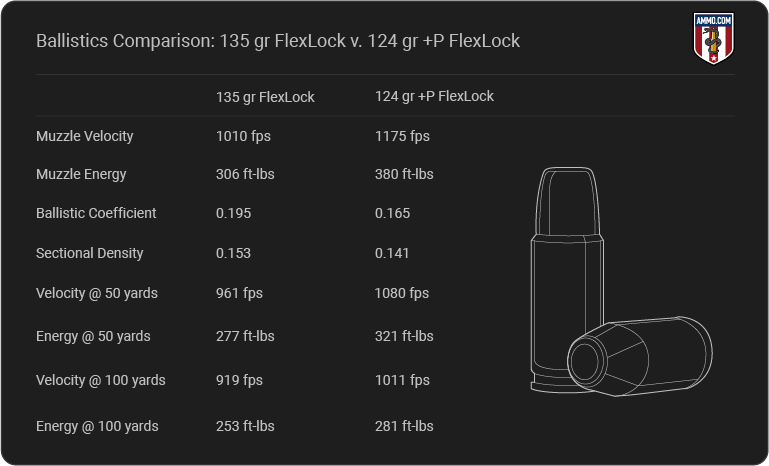
Parting Shots
Hornady Critical Duty ammo is a great 9mm Luger option for self-defense and concealed carry. It smashes through barriers, decimates the FBI Protocol, and is more than powerful enough to protect you or your loved ones.
Although some shooters may love the FBI-approved cartridge, it does come at a higher price point than Hornady Critical Defense 9mm ammo, and most civilian shooters won’t need the level of barrier penetration the Critical Duty offers.
However, if you want the best of the best, then you can’t go wrong with Hornady Critical Duty 9mm Luger ammo. If you are in the market for some Critical Duty ammunition, then make sure to check out our Hornady Ammo in stock HERE.
Frequently Asked Questions
Below, we've taken the liberty to round up a few commonly asked questions about Hornady Critical Duty 9mm ammo.
Is Hornady Critical Duty 9mm ammo worth buying?
Yes, Hornady Critical Duty 9mm ammo is an exceptional handgun defense load that is carried by law enforcement officers and CCW permit holders across the USA. It passes all the FBI Protocol gel tests and offers you exceptional weight retention, penetration, and expansion for any self-defense scenario.
What is the range of Hornady Critical Duty 9mm ammo?
Hornady Critical Duty 9mm ammo will be effective at all typical self-defense distances or for home defense. It’s a great option for your full-size handgun like a Sig Sauer P320, compact EDC pistols like a Glock 19, or even a subcompact carry gun like a Taurus PT709s or Glock 26.
Ammunition Reviews
- Federal Punch Ammo Review
- Magtech 5.56 Ammo Review
- Hornady 6mm ARC Ammo Review
- Hornady LeveRevolution 30-30 Ammo Review
- Hornady Superformance 6.5 Creedmoor Ammo Review
- Hornady Critical Duty 9mm Ammo Review
- Federal 22LR AutoMatch Ammo Review
- Golden Tiger 7.62x39 Ammo Review
- Federal Non-Typical Ammo Review
- CCI Blazer Aluminum 9mm Ammo Review
- Hornady SST Ammo Review
- Aguila Minishells Review
- Federal American Eagle Ammo Review
- Hornady American Whitetail Ammo Review
- Rio Shotgun Shells Review
- Hornady Frontier 5.56 Ammo Review
- Aguila .22LR Ammo Review
- Federal Training Ammo Review
- Hornady Critical Defense 9mm Review
- Federal Hydra-Shok 380 Review
- Wolf Military Classic 7.62x39 Review
- Federal Syntech Review
- Hornady Critical Defense Review
- Hornady SST Muzzleloader Bullets Review
- Federal Hydra Shok 12 Gauge Slug Review
- Hornady American Whitetail 223 Review
- Hornady Black Ammo Review
- Federal Power Shok Ammo Review
- 338 Lapua Ammo Review
- Hornady American Gunner 300 Blackout Ammo Review
- Federal MeatEater Ammo Review
- Blazer Brass 380 Ammo Review
- Blazer 9mm Luger Review
- Hornady LeveRevolution 44 Mag Review
- Federal Independence Ammo Review
- PMC X-TAC 5.56 Ammo Review
- Hornady Superformance 30-06 165gr SST Review
- Federal Champion 9mm Ammo Review
- Blazer Brass 9mm Ammo Review
- Magtech 9mm 124gr Ammo Review
- Magtech 308 Win 168gr HPBT Ammo Review
- Sellier and Bellot 9mm 124gr Ammo Review
- Rifle Line Ammo Review
- Wolf Performance 7.62x39 Ammo Review
- Wolf 6.5 Grendel Ammo Review
- Sellier and Bellot 300 Blackout Subsonic Ammo Review
- Magtech 45 ACP Ammo Review
- Brown Bear 223 Ammo Review
- Hornady Full Boar 223 Ammo Review
- Federal Hydra Shok 9mm Review
- 270 Hornady American Whitetail Review
- Hornady American Whitetail 308 165-Grain Review
- Blazer 9mm 115-Grain Review
- Hornady Black 6.5 Grendel Ammo Review
- Hornady 300 Blackout 190 Gr Sub-X Review
